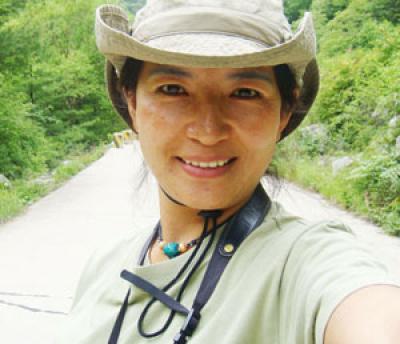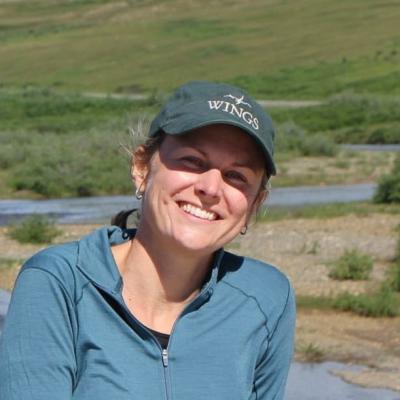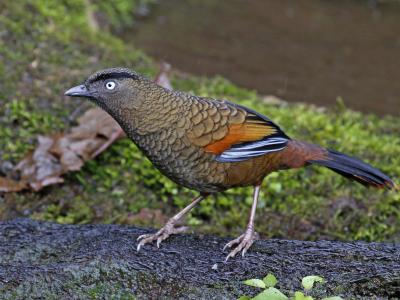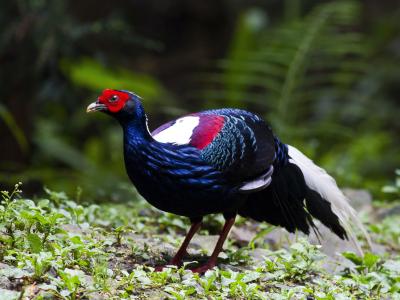China: The South in Winter
-
Jan 11-26, 2026
Paul Holt and Wang Qingyu
-
Jan 10-25, 2027
Paul Holt and Wang Qingyu
2026
Single Room Supplement $1,990
2027
Tour Price to be Determined
2026
Single Room Supplement $1,990
2027
Tour Price to be Determined
Understandably given its huge size, China has a massive variety of habitats and an equally varied and fascinating avifauna. We’ve been offering tours to China for more than two decades and this new tour is a major overhaul of a WINGS favorite – our winter waterbird spectacular. We still visit Poyang Hu National Nature Reserve, an outstanding site with its fabulously evocative cranes of four, occasionally five, species including the mythical Siberian and Hooded. The supporting cast has included a world-class list of waterbirds and we expect to see thousands of Swan Geese, hundreds of Falcated Duck and at least a few Baikal Teal, while nearby we stand a good chance of encountering reasonable numbers of Scaly-sided Merganser at the world’s most reliable wintering site. Other specialties should include huge parties of Oriental Stork, the spectacular Mandarin Duck and the diminutive Pied Falconet. We even have a chance of seeing the rare Baer’s Pochard, and perhaps even a Japanese Waxwing or with luck a wintering Swinhoe’s Crake!
Our radically revamped itinerary now includes visits to two sites on tropical Hainan Island, Nonggang Nature Reserve in Guangxi, and some birding in Beijing, China’s historic capital and political center. We’ll spend several days on Hainan Island, where we’ll target the islands endemics – Hainan Leaf Warbler, Hainan Partridge and if we’re extremely lucky Hainan Peacock-pheasant. Other species in the rich tropical forests include Large Scimitar and Spot-necked Babblers, Eyebrowed Wren-Babbler and both Rufous-cheeked Laughingthrush and the monachus form of Black-throated Laughingthrush. Further north on the island we have a very good chance of seeing the critically endangered Spoon-billed Sandpiper at one of its most accessible regular wintering sites. That area also hosts a fascinating selection of night birds including Bay and Eastern Barn Owls. Leaving Hainan, we’ll visit Nonggang reserve in Guangxi, a site that shot to ornithological fame early this century with the discovery of the aptly named Nonggang Babbler. Comprehensive surveys have shown it to be rare, but it’s easy to see from the photographic blinds that enterprising locals have built. After Poyang Hu and a couple of neighboring sites we’ll return to Beijing where we’ll search for species such as Siberian Accentor, Pallas’s, Chinese Beautiful and Chinese Long-tailed Rosefinches and Güldenstädt’s Redstart.
China has come a long way in the past few decades. Besides hosting an increasing number of comfortable hotels, this fascinating country now boasts an impressive transport infrastructure, which we’ll make good use of on this unusual tour.
Day 1: The tour begins this evening in Beijing. Night in a hotel near Beijing Capital International airport.
Day 2: We’ll fly south to Sanya at the southern tip of tropical Hainan Island, well known for its gorgeous beaches and as a winter tourist destination for mainland Chinese. It’s been developing at break-neck speed in recent years, but fortunately for birders, areas not too far away still hold some impressive forests and a rich array of highly sought-after species. We’ll visit the very best of these, Jianfengling, where a National Nature Reserve protects an extensive area of upland native forest. A comfortable resort and forest boardwalk give us ideal access and we’ll spend three nights and two full days here searching for our target species, including three island endemics - Hainan Leaf Warbler, the elusive island Hainan Partridge and extremely elusive Hainan Peacock-pheasant. The warbler is common and relatively easy to find, the partridge invariably requires a degree of stealth and modicum of patience while coming upon a Peacock-pheasant is largely down to luck. Night at Jianfengling.
Days 3-4: We’ll spend two full days at Jianfengling, ample time to look for other specialties in the rich forest. These include a variety of nightbirds such as Mountain and Collared Scops Owls as well as the impressive Brown Wood Owl. Both Red-headed Trogon and the grouchy sounding Blue-bearded Bee-eater are regular and rather vocal, but the demure Silver-breasted Broadbill far less so. Other vociferous species should include Sultan Tit, Clicking Shrike-babbler, Streak-breasted and Large Scimitar Babblers, Spot-necked Babbler, Eyebrowed Wren-Babbler and both Rufous-cheeked and the monachus form of Black-throated Laughingthrushes. The diminutive Yellow-billed Nuthatch, a species whose disjunct range is otherwise restricted to a handful of mountains in Vietnam and south-eastern Laos, is often fairly common close to our guest house as is White-crowned Forktail. Hainan is the winter home to variety of mostly skulking thrushes that could include Orange-headed, Japanese and Eyebrowed, as well as flycatchers including Hainan Blue, Pale Blue and Mugimaki. Nights in Jianfengling.
Day 5: After a final morning we’ll leave Jianfengling and drive north, about halfway towards Haikou, the provincial capital. Danzhou Bay on the island’s west coast has recently been found to hold modest numbers of wintering Spoon-billed Sandpiper, one of the world’s rarest and most enigmatic waders. The coastal mudflats, just a short distance from our hotel, are now arguably the best site in the whole of China, and one of the most accessible and reliable on the planet for the species. The extensive areas of heavily corrugated, sandy mud flats exposed at low tide appear to be irresistible to "Spooners" and as many as a dozen have been found here in recent winters. With the first individuals of this superbly distinctive species probably arriving in mid-September, and a few remaining into early May, our tour is perfectly timed to coincide with the period when this diminutive shorebird is at its most dependable. Night in the Danzhou Bay area.
Day 6: Large numbers of other shorebirds, hopefully including the very localized White-faced Plover, recently split from Kentish Plover, and east Asian specialties such as Greater and Lesser Sand Plovers (with luck the latter including both Siberian and Tibetan forms), Great Knot, Broad-billed Sandpiper and Red-necked Stint. Other target species include King (or Blue-breasted) Quail and an impressive array of poorly known owls - Eastern Barn, Eastern Grass and Oriental Bay. Night in the Danzhou Bay area.
Day 7: After a final morning in the Danzhou Bay area we’ll continue north on to Haikou before flying a short distance north to Nanning in southern China’s Guangxi Province. From there we’ll drive east to Longzhou. Night in Longzhou.
Day 8: Nonggang Babbler, a species only discovered at the start of the current century, will be our primary target in Guangxi. It’s rare, with a world population recently estimated at less than 1300 individuals, but luckily for us it’s locally common and easy to see in its namesake nature reserve. We’ll be in an area that’s rather remote, very close to the Vietnamese border and surrounded by spectacular limestone karst scenery, just as dramatic as that around the world-renowned Guilin. Here lush forests cling to seemingly impossibly steep massifs that rise abruptly from the flat and intensively cultivated valley floor. Enterprising locals have established a series of photographic bird blinds that have proved hugely attractive to both birds and local bird photographers, and it’s in these bird blinds that we’ll spend much of our time. Regular visitors include Blue-rumped Pitta, Indochinese Green and White-winged Magpies, Black-throated Laughingthrush (here of the nominate chinensis form), and Hainan Blue Flycatcher. Night in Longzhou.
Day 9: We’ll spend most of the day in the Nonggang Nature Reserve searching for species we might have missed such as Chinese Barbet, White-browed Piculet, Long-tailed Broadbill, Black-crested Bulbul, Limestone Leaf Warbler, Buff-breasted Babbler, Streaked Wren-Babbler and David’s Fulvetta. In the afternoon we’ll drive back to Nanning. Night in Nanning.
Day 10: We’ll fly from Nanning north to Nanchang, the capital of Jiangxi Province. We’ll then drive, via a series of wetlands near Jiujiang where we’ve seen Baer’s Pochard, to Wuyuan, a picturesque small town in the northeastern corner of the province, and home to several more target species including the tiny Pied Falconet, Mandarin Duck and Red-billed Starling. Night in Wuyuan.
Day 11: We’ll spend the day around Wuyuan, searching for the area’s other specialties with the rare Scaly-sided Merganser one of our main aims. Up to sixty birds have been counted wintering here in recent years, and we’re likely to find a few parties of this attractive “sawbill”. Other species along this stretch of river could include Long-billed Plover and Black-collared Starling, while elsewhere around Wuyuan we’ll look for Yellow-browed Bunting, that magnificent songster the Chinese Hwamei, and, with luck, Japanese Waxwing. Night in Wuyuan.
Day 12: We’ll spend the morning searching for Chinese Bamboo Partridge, Grey-sided and Streak-breasted Scimitar Babblers, Gray-chinned Minivet and, with luck, a Spotted Elachura or Short-tailed Parrotbill, along with any species we might have missed the day before. In the late afternoon we’ll start the journey to Poyang Hu. Night outside the nature reserve.
Day 13: It shouldn’t take us long to reach the world-renowned Poyang Hu from our hotel and we’ll spend all day exploring this fabulous reserve. Poyang Hu is subject to huge annual fluctuations in its water level: the lake covers up to 2,000 square miles during the summer rainy season, but water levels can fall by as much as 50 feet by the end of the winter, shrinking the lake to an area less than 10% of its summer maximum. The result is a mosaic of shallow residual lakes, and it’s the combination of these along the fairly mild winters that creates ideal conditions for tens, even hundreds of thousands of waterbirds.
One of the most important wetlands in the world, Poyang Hu holds the planet’s largest concentrations of several threatened or endangered species. The magnificent Siberian Crane is undoubtedly the reserve’s star attraction, with more than 95% of the world population (3,200 birds) wintering here along with even larger numbers of the equally majestic White-naped Crane. Hooded Crane is decidedly scarcer, but if the weather is good, we should be able to find one or two of them among the huge flocks.
We’ll make extensive use of boats during our stay. The ancient tradition of cormorant-fishing is still practiced at Poyang Hu, and we might even see a group of these tethered working birds. Thousands of Tundra Swan and Tundra Bean, Greater White-fronted, and Swan Geese spend their winter here, alongside hundreds of Oriental Stork and huge swirling flocks of Spotted Redshank and Pied Avocet. Other, less conspicuous species include Marsh Grassbird and Baikal Teal. With a great deal of luck, we might even find a Swinhoe’s Crake. Night at Yongxiu, a small town just outside the reserve.
Day 14: We’ll leave Yongxiu early and drive a short distance south to spend the morning exploring Nanjishan Reserve. Marsh Grassbird and Swinhoe’s Crake are more regular here than at Poyang Hu, and we’ll concentrate on those two species in particular. In the afternoon we’ll return to Nanchang airport for our flight back to Beijing. Night near Beijing Capital International Airport.
Day 15: We’ll depart early on our drive into the mountains west of the Chinese capital. Being significantly further north, Beijing boasts a very different avifauna to those at our previous sites. Our destination holds extensive stands of berry-laden Sea Buckthorn that frequently attract large numbers of thrushes, predominantly Red-throated, Dusky and Naumann’s, as well as the gorgeous Güldenstädt’s Redstart and Chinese Beautiful, Pallas’s and the recently split Chinese Long-tailed Rosefinches as well as both Bohemian and, if we’re lucky, Japanese Waxwings. Red-billed Chough, Plain Laughingthrush, Beijing Babbler, and Godlewski’s and Meadow Buntings are usually common while other species could include Cinereous Vulture, Spotted Nutcracker and perhaps even a Northern Shrike.
Leaving in the early afternoon we’ll make a couple of stops in the lowlands as we head back to the bustling metropolis, including a visit to a wetland on the city’s western flank where we hope to find a party of Daurian Jackdaw, the near-endemic Chinese Grey Shrike, Reed Parrotbill and/or Bearded Reedling. Night in Beijing.
Day 16: The tour ends this morning at Beijing Capital International Airport.
Note: The information presented below has been extracted from our formal General Information for this tour. It covers topics we feel potential registrants may wish to consider before booking space. The complete General Information for this tour will be sent to all tour registrants and of course supplemental information, if needed, is available from the WINGS office.
ENTERING CHINA: United States citizens will need a passport valid for at least six months from date of departure and with at least two blank pages for entry and exit stamps. A tourist visa is also required to enter China.
Citizens of other countries may need a visa and should check their nearest Chinese embassy. If required by the embassy or visa-granting entity, WINGS can provide a letter for you to use regarding your participation in the tour.
COUNTRY INFORMATION:You can review the U.S. Department of State Country Specific Travel Information at https://travel.state.gov/content/travel/en/international-travel/International-Travel-Country-Information-Pages/China.html, and the CIA World Factbook background notes on China at https://www.cia.gov/the-world-factbook/countries/china/.
PACE OF TOUR AND DAILY ROUTINE: This is not a particularly strenuous tour. There is a reasonable amount of travelling between one site and the next and a couple of the days are long and tiring. However, at this time of year the days are fairly short (the sun rises on average at about 07h00 and sets at about 17h15) and consequently the time we can spend in the field is fairly limited. Even so on a number of days we will leave our accommodation at about 05h30, an hour or so before we can see, and most days we will have picnic breakfasts in the field. It’s likely that we will also have a large number of picnic lunches in the field throughout the tour, but we will return to our accommodation for all of our evening meals.
At Jianfengling NNR on Hainan, we will rarely be more than two kilometres from our accommodation and most mornings we expect to have a picnic breakfast before we head out to walk on the circular boardwalk that starts and finishes besides our guest house in the early morning and return in the late morning. We will usually have a sit-down lunch and head out again mid-afternoon returning for dinner. During our time in the Danzhou Bay area and at Nonggang Reserve in Guangxi we also expect to have a picnic breakfast near the day’s first birding site and we are very likely to also have picnic lunches in those same two areas. At several of the sites we will visit around Wuyuan and at Poyang Hu National Nature Reserve (NNR) we will typically leave the hotel for a full-day’s birding sometime between 05h30 and 06h15 and will take a picnic breakfast with us.
The birding site in the mountains to the west of Beijing is about a three-hour drive from our hotel and we expect to leave early, possibly as early as 04h30 in order to be on site shortly after sunrise. We will have a picnic breakfast and a picnic lunch on site.
We try to make as many of our birding excursions as possible optional, so that if you find the pace too tiring it is possible to take some time off and relax. Essentially, we aim to provide dawn to dusk birding for those who want it and as many opportunities as possible to opt out for those who wish to pursue other interests or simply relax.
HEALTH: The Centers for Disease Control and Prevention (CDC) recommends that all travelers be up to date on routine vaccinations. These include measles-mumps-rubella (MMR) vaccine, diphtheria-tetanus-pertussis vaccine, varicella (chickenpox) vaccine, polio vaccine, and your yearly flu shot.
They further recommend that most travelers have protection against Hepatitis A and Typhoid.
Please contact your doctor well in advance of your tour’s departure as some medications must be initiated weeks before the period of possible exposure.
The most current information about travelers’ health recommendations can be found on the CDC’s Travel Health website at https://wwwnc.cdc.gov/travel/destinations/traveler/none/china?s_cid=ncezid-dgmq-travel-single-001
Note: There are COVID-related entry requirements in place for U.S. citizens.
Altitude: The majority of the tour will be spent at altitudes of less than 250 metres or 820 but at Jianfengling National Nature reserve on Hainan island we are likely to spend most of our time between 900-1100 metres or 2950 – 3600 feet. In Beijing we will drive up to about 1600 metres or 5250 feet. We will be doing quite a lot of walking, perhaps especially at Jianfengling and at Poyang Hu, and some of this might be on flagged steps or through reasonably long grass that can be a little tiring. This said such ‘grassland walks’ will be short and none of our walks will be particularly strenuous.
Miscellaneous: Very few biting insects are active in South China in winter, but there still may be isolated concentrations of day-flying mosquitoes at one or two sites. We recommend that you bring an insect repellent and, if you are sensitive to bites, an antihistamine.
Tap water is not safe to drink anywhere in China. Bottled water and soft drinks are widely available and your room will normally be supplied either with a large thermos flask of boiled water or a kettle with which you can make tea or coffee. We provide bottled water in the vehicle during the day.
Smoking: Smoking is not allowed in the vehicle, nor at meal times or when the group is gathered together for the checklist. If you are sharing a room with a non-smoker, please don’t smoke in the room. If you smoke in the field, please stand down wind of the group. If any lodge, accommodation or location where the group is staying or is gathered has a more restrictive smoking policy than WINGS’ policy, the more restrictive policy will prevail.
Note: None of the hotels that we’ll use have designated non-smoking rooms so the rooms we use might have been previously occupied by a smoker. While the bed linen will certainly be clean, cigarette odours in the bed rooms are fairly common.
CLIMATE: The weather on this tour will vary enormously. South China is typically quite sunny and dry from October through to the end of January. It is likely to be significantly warmer at the sites that we will visit on Hainan and in Guizhou. Temperatures at Sanya in southern Hainan are likely to range from about 18 - 26°C (64 - 79°F) while in the forest slightly further north at Jianfengling (where we’re likely to spend most of our time between 900-1100 metres or 2950 – 3600 feet) they’re likely to be slightly less than this – perhaps ranging from about 15-26°C (59 - 79°F). It will be humid here and at Nonggang in Guizhou. We will be in the forest most of the time while at Jianfengling but the same will not be true at our next destination, the Danzhou Bay area in northern Hainan. There’s far less shade at several of the sites that we’ll visit in that area. January temperatures there and in Haikou range from 15 - 23°C (59 - 73°F). At Nanning January temperatures typically range between 10 - 17°C (50 - 63°F) and those at Nonggang will be essentially the same. Since this is a winter trip, temperatures at Poyang Hu are likely to be cold, especially at night. Early morning temperatures during our time there and near Wuyuan will normally be around 4-5°C (39 - 41°F) rising to a maximum of about 12-13°C (54 - 56°F) midday, but possibly as high as 16-17°C (61 - 63°F). However, even in those area it can be colder than this, perhaps especially in the hills near Wuyuan and we should be prepared for early morning temperatures to occasionally drop to perhaps 5-7°C below freezing (19 - 23°F). It is important to remember that it can feel much colder if the wind is blowing. In southern China in winter the humidity can be quite high and unfortunately there is a reasonable chance of early morning fog at Poyang Hu. There is also a reasonable chance of rain at some time during the tour and again this is perhaps most likely around Poyang Hu.
Beijing will easily be the coldest place that we will visit. Temperatures in the city range from about 0 - 14°C (0 - 32°F) during January but it is likely to be significantly colder than that in the mountains. On that day we will drive up to about 1600 metres or 5250 feet where early morning temperatures could be a low as minus 15°C (5°F). Even midday temperatures are unlikely to climb much above a frigid minus 7°C (19°F). If it is not windy multiple layers of clothing, including a jacket to keep out any breeze, a warm hat and thick gloves, will suffice. Wind chill can significantly affect our perception of the temperatures. In Beijing we will never be very far from our vehicle and will have regular access to hot drinks.
ACCOMMODATION: Varied. We will spend the first night of the tour in a clean and comfortable hotel very close to Beijing Capital International Airport. Ranked as an international 4-star hotel, the rooms are clean, warm and comfortable. The hotel has several restaurants, a bar and spacious lobby lounge. It also offers room service, an express laundry service and most amenities that you’d expect from a hotel of an international 4-start ranking. We will spend two more nights at this same hotel at the end of the tour. We spend the next three nights of the tour in a decent guest house at Jianfengling on Hainan. This guest house is very close to the birding and the boardwalk where we will spend most of our time starts right beside it. All the rooms are clean, and all have en suite bathrooms with western toilets and showers. We will also have our evening meals in the hotel’s restaurant. Moving on from Jiangfengling our next stop will be near Danzhou Bay in north-western Hainan. The hotel there is better. A new hotel, it’s a Chinese 4-star standard (roughly equivalent to a 3-star establishment in the west). We will spend two nights in that hotel and expect to have both of our evening meals there. Moving on again we will spend the next two nights in a hotel in Longzhou, about a 30-minute drive from Nonggang Reserve in Guangxi. The hotel there is older, and about a 3-star equivalent. Once again, all the rooms have on suite facilities including a western toilet and shower, and once again the rooms are clean and warm. Leaving Longzhou we will spend one night in a comfortable hotel near Nanning airport. Ranked equivalent to a western 4-star hotel it is new and comfortable. After that we will spend the next two nights in a comfortable three-star hotel in Wuyuan followed by two more nights in a hotel of a similar standard near Poyang Hu NNR. Recently refurbished, both of those hotels are of a good standard and are the best in the area. All the rooms are clean and warm and each has a television and en suite facilities including a shower and western toilet. We will also have our evening meals at each of these places in the hotel’s restaurant.
Internet and Mobile Phone Access: As you would expect an ever-increasing number of hotels that we use have internet access and WIFI is available in the rooms of our hotels in Beijing, Danzhou Bay on Hainan, in Longzhou, Nanning, Wuyuan and near Poyang Hu. It is also available at most of the domestic airports that we will visit. Participants should be aware, however, that internet access is occasionally suspended in China – perhaps because of floods, landslides, or political issues. Please note that a modest number of western websites, such as Facebook, YouTube, Dropbox, the Google search engine, and Gmail accounts are actively blocked by the Chinese government. Mobile phone coverage is superb over most of China and, while not all foreign mobile operators have agreements with the Chinese carriers, many do. You are advised to contact your mobile phone provider in advance of the trip to confirm this. Mobile phones can be useful while on tour but keep in mind that many countries operate on a different cellular technology. Your phone may be incompatible with the local system, so please check with your local carrier. Fortunately, with the advent of smartphones, it is easy to download applications such as Skype or Google Voice, which can make calling home free or very inexpensive. Note however that most of these are also actively blocked by the Great Firewall. Another option is to replace the data (“SIM”) card in your phone in-country. The SIM cards, including data can be very cheap. If you wish to use this option, you will need to check that your smart phone has a SIM card slot.
FOOD: Western food will only be available in our hotel in Beijing. In the more remote areas, we will of course be eating Chinese food, which on the evidence of past visits is often excellent and generously supplied. Green tea and soft drinks, mineral water or beer are served with the main meals. Chinese breakfasts are typically unpopular with Western tourists, and we will usually have picnic breakfasts provided by our ground agent. In these past, these have consisted of items such as western cereals, milk, fruit (often bananas, oranges, and apples), yoghurt, chocolate bars such as Snickers, sachets of instant coffee (normally with milk and sugar already included since ‘untainted’ coffee is less widely available), tea, rice crackers and biscuits. We also expect to be having quite a number of picnic lunches and these are often eaten out in the field. These lunches consist of many of these same items often supplemented by boiled eggs, instant noodles, peanuts, and sometimes boiled potatoes. On a few occasions (where fresh bread is available) we will also have jam, peanut butter, cheese and/or ham sandwiches. Both instant coffee (with sugar) and English-style tea are now quite widely available in China but nevertheless, you might like to bring tea bags, instant coffee (without sugar) and powdered milk. These last two items are also useful for converting congee, a watery rice gruel often served at sit-down Chinese breakfasts, into rice pudding. You might also consider bringing Muesli bars, Mars bars, packets of soup, instant noodles etc. Our ground agent will provide a number of large thermos flasks that will be useful for making hot drinks and noodles for our days in the field. We expect to have a sit-down breakfast on only a couple of occasions – in the hotels that we will use near Nanning airport and in our Beijing airport hotel on the very first and last mornings of the tour.
The Chinese way of eating food differs from the western way. A selection of different dishes is shared by those sitting at the same table and chopsticks are used. Food is almost always plentiful. Outside of Beijing very few, if any, restaurants will provide knives and forks. Instead chopsticks, sometimes even disposable wooden ones, are used. If you are not used to eating with chopsticks, we suggest you start practising right away, or bring your own cutlery.
WINGS tours are all-inclusive, and no refunds can be issued for any tour meals participants choose to miss. While we will try to do what we can to accommodate the requirements of all participants, please note that we cannot guarantee all causes of food allergies can be avoided at every destination. Many restaurants offer set menus and are unable to accommodate all special requests within a group. Thus, participants with significant food allergies or special dietary needs should bring appropriate foods with them for those times when their needs can, regretfully, not be accommodated. Our tours are carefully scheduled to ensure the best possible birding experience and although the leaders will do all they can to make sure the group eats at a reasonable time, sometimes early or late lunches and/or evening meals cannot be avoided. Any participants who need to eat at specific times may need to bring supplemental food with them.
Drinks: Bottled water and/or a soft drink or a beer is provided at lunch and dinner, as is coffee or tea. All other drinks or ”personal” drinking water for use in your room, etc., are the responsibility of the individual. Bottled water will be provided during the day in our tour vehicles.
TRANSPORTATION: Transportation is mostly by a variety of small buses. Some of the minibus rides may last for up to five hours, but we will, of course, make regular stops along the way to stretch and to bird watch. While most road journeys will be made along paved or hard surfaced roads, in some areas the roads will be rougher. This is especially true of some of the minor roads around Wuyuan and at Poyang Hu. The leader will arrange a seating rotation. Participants should be able to ride in any seat in tour vehicles.
We will also use one or possibly two small boats to access several of the sites at Poyang Hu. Individual boat journeys at Poyang Hu might last for up to 1.5 hours, we will charter the entire boat and expect to keep it for the entire day.
We will also have four internal flights. The flights that we will be taking on Chinese airlines are of an international standard.
Maximum group size nine participants with two leaders. Both leaders will accompany the tour irrespective of group size.































